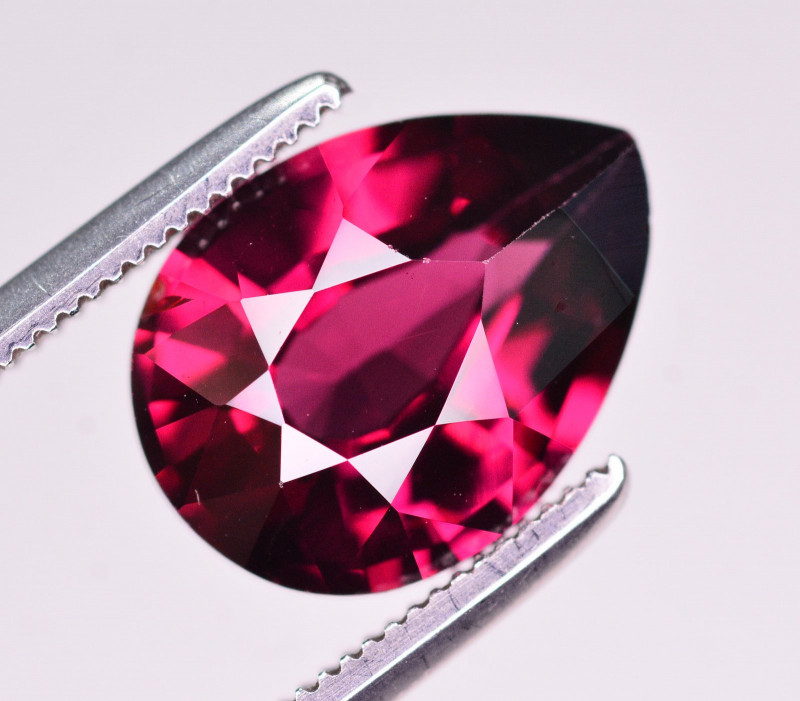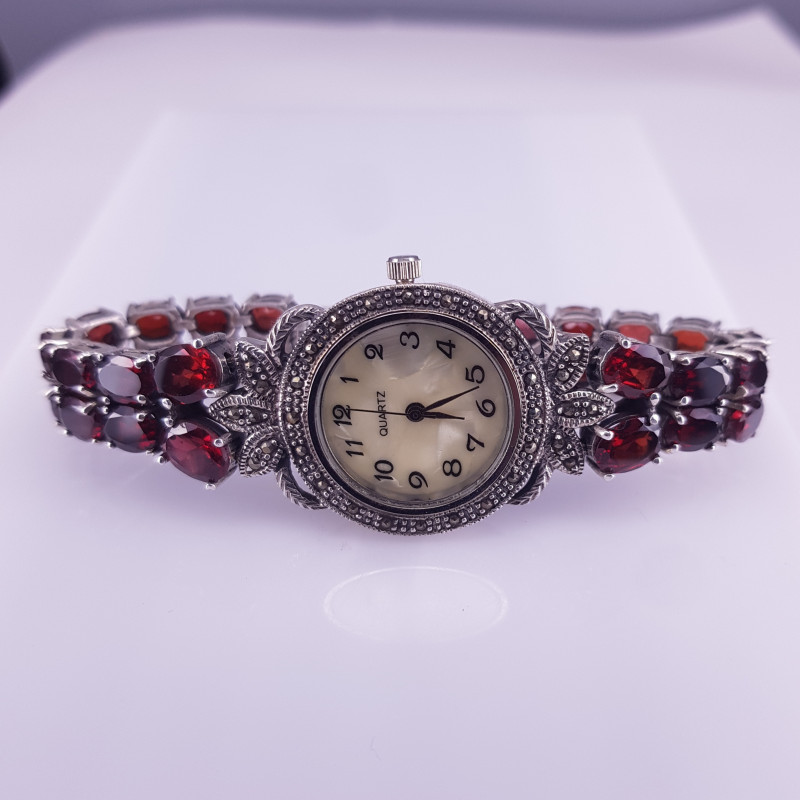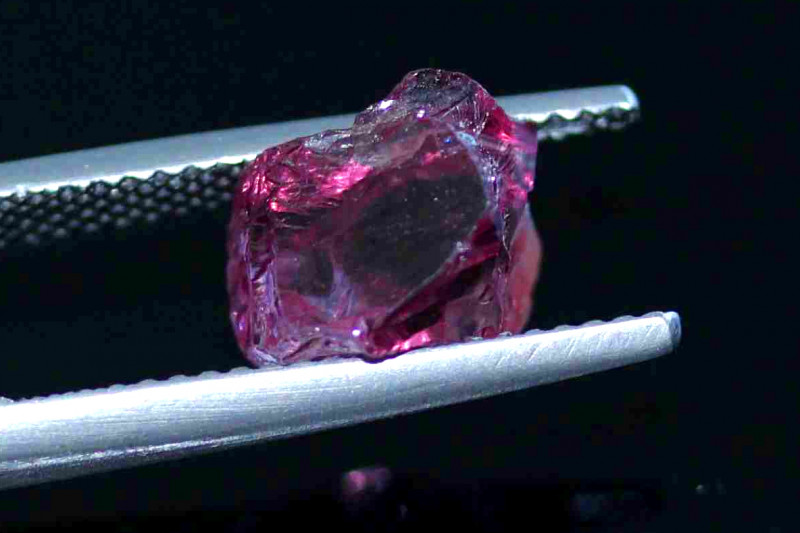
镁铝榴石:含义、价格和属性信息指南
 镁铝榴石是最著名的红色石榴石品种,尽管其颜色各异。镁铝榴石是宝石吗?绝对是!它最常用于刻面、血红色或石榴色的宝石中。它是唯一一种始终呈现红色的石榴石。
镁铝榴石是最著名的红色石榴石品种,尽管其颜色各异。镁铝榴石是宝石吗?绝对是!它最常用于刻面、血红色或石榴色的宝石中。它是唯一一种始终呈现红色的石榴石。
镁铝榴石稀有吗?并非如此。虽然它不如其他石榴石丰富,但却是最受欢迎的珠宝材料之一。
如果您准备好了解镁铝榴石,请加入我们,我们将详细了解镁铝榴石的含义、价格、历史等!

关于镁铝榴石
镁铝榴石是一种半宝石,有很多别名。一些常见的别名是“波西米亚石榴石”或“开普红宝石”。然而,镁铝榴石并非红宝石,因此美国联邦贸易委员会 (FTC) 禁止以这些名称销售镁铝榴石。
对于新年宝宝们来说,镁铝榴石是你们一月的诞生石!它也是白羊座、摩羯座和水瓶座的星座石。石榴石也是庆祝结婚两周年的传统礼物!
镁铝榴石规格和特性
石榴石家族主要有两个品种:镁铝榴石和磷铝榴石。镁铝榴石与锰铝榴石、铁铝榴石同属磷铝榴石系列。
镁铝榴石是一种镁铝硅酸盐。镁铝榴石中常见的杂质有钙、铁、锰和铬。
纯镁铝榴石的化学式为Mg3Al2Si3O12或Mg3Al2(SiO4)3,但天然镁铝榴石从来都不纯净。在宝石级宝石中发现的最高镁铝榴石含量可达83%。
铁铝榴石和镁铝榴石很难区分。从化学角度来看,镁铝榴石含镁量更高,而铁铝榴石含铁量更高。区分两者的最佳方法是密度——铁铝榴石的典型密度为4.3,而镁铝榴石的典型密度为3.6。
其余镁铝榴石矿物数据如下:
莫氏硬度:7-7.5
颜色: 红色、粉色、棕红色、紫红色、橙红色、黑红色、紫色
晶体结构:等轴/立方
光泽:玻璃光泽或油脂光泽
透明度:透明至不透明
折射率:1.73-1.76
密度:3.65-3.87
解理:无
断口:贝壳状
条痕:白色
发光:无
光学效果:很少变色

镁铝榴石的种类
镁铝榴石只有一个正式品种——铬镁铝榴石。然而,镁铝榴石通常会与其他种类的石榴石混合,形成新的品种。
铬镁铝榴石

铬镁铝榴石富含铬,因此呈现出更深的红色。它也可以呈现紫红色。氧化铬含量在3%到8%之间的铬镁铝榴石,颜色为紫罗兰色至深紫色,并带有绿色底色。
它们最为著名,产于美国亚利桑那州,人们在蚁丘周围的蚂蚁群中发现了它们被丢弃的痕迹。
那么,镁铝榴石和蚁丘石榴石一样吗?差不多。蚁丘石榴石是由蚂蚁挖出来的,是浓郁鲜红色的铬镁铝榴石,体积较小(蚂蚁能挖的量有限)。
粉彩镁铝榴石

粉彩镁铝榴石由宝石学家卡罗尔·斯托克顿于 1988 年首次提出,尽管未经官方认可,但它是一种浅粉色、栗色、橙红色或紫色的品种。
它们的镁铝榴石含量为74%至88%,铁和锰含量较低,但镁含量较高。然而,它们的折射率低于其他镁铝榴石。
莫桑比克石榴石

莫桑比克石榴石是产于非洲莫桑比克的镁铝榴石和铁铝榴石的混合物。这些石榴石呈红色,并带有橙色和棕色的底色。
玫瑰榴石也是镁铝榴石和铁铝榴石的混合物。不过,莫桑比克石榴石颜色更红、颜色更深,而且通常铁铝榴石的含量比镁铝榴石更高。
红榴石

玫瑰榴石是镁铝榴石和铁铝榴石的近乎均匀的混合物。传统上,被称为“玫瑰榴石”的宝石呈紫红色,但其颜色范围从浅玫瑰红色到紫罗兰色或紫色。
有时,玫瑰榴石中也会混入锰铝榴石。锰铝榴石的颜色通常较浅。如果存在铁和镁杂质,玫瑰榴石会变成深紫色,有时被称为“葡萄石榴石”。
此外,由三种柱状石榴石组成的坦桑尼亚玫瑰榴石具有明亮的洋红色和淡粉色光泽,被称为“紫罗兰石榴石”。
变色石榴石(马来亚石榴石等)


虽然几乎所有石榴石种类都有变色的品种,但最常见的是镁铝榴石-锰铝榴石混合物。
马来亚(或称马拉亚)石榴石是稀有但颇受欢迎的品种之一,属于镁铝榴石-锰铝榴石或磷铝榴石类。马来亚石榴石通常呈粉红色至橙色,但变色品种在日光下可能呈现粉红色、橙红色或洋红色,在白炽灯下则呈现红粉色、浅紫色、粉红色或粉橙色。
最引人注目的变色镁铝榴石是20世纪90年代发现的一种以镁铝榴石-锰铝榴石为主、颜色由蓝绿到紫色变幻的变色镁铝榴石。这类变色镁铝榴石的售价高达480万美元!
其他变色镁铝榴石来自:
爱达荷州:镁铝榴石-铁铝榴石,红色至紫红色
东非:粉彩镁铝榴石,粉红色至紫色
挪威:镁铝榴石-铁铝榴石,紫红色至蓝绿色或紫红色至酒红色
坦桑尼亚:镁铝榴石-锰铝榴石,绿蓝色至洋红色或粉紫色至亮粉色至紫色
了解镁铝榴石的象征意义和历史!

镁铝榴石的含义和历史
镁铝榴石承载着传统的石榴石传说。镁铝榴石与石榴石(石榴石名称的灵感来源之一)息息相关,同样象征着爱情和鲜血。
古时,人们相信红色石榴石能为旅人照亮前路,保佑他们平安。中世纪时期,人们用红色石榴石来治疗噩梦、出血和抑郁症。
古希腊人认为石榴石是解毒剂,可以防止儿童溺水。在美国,美洲原住民用蚁丘石榴石制作拨浪鼓,用于仪式或表达感激之情的礼物。
与镁铝榴石相关的一些宗教传说包括:
象征基督教中耶稣基督的血祭
照亮伊斯兰教的第四层天堂
犹太教中,诺亚用灯笼引导方舟穿越洪水
让我们从传说走进镁铝榴石的过去!
古代史
“镁铝榴石”这个名字源于希腊语pyrōpos ,意为“火红的眼睛”。( Pyr 的意思是“火”, ōps 的意思是“眼睛”。)这反映了宝石的高折射率、颜色和闪光。
第一个使用“pyropus”的人是公元 300 年左右的拉丁地理学家和语言学家盖乌斯·尤利乌斯·索利努斯 (Gaius Julius Solinus)。
考古证据表明,石榴石宝石可以追溯到公元前3100年的埃及珠宝。古罗马人经常佩戴图章镁铝榴石戒指,埃及法老下葬时也佩戴着石榴石项链。
据称,公元前4世纪著名哲学家柏拉图曾要求将自己的肖像雕刻在石榴石上。据罗马博物学家老普林尼称,红色石榴石是公元1世纪最受欢迎的宝石之一。
红色石榴石的早期名称是“红宝石”,特别是凸圆形宝石。

中世纪至维多利亚时代
在中世纪(公元1世纪至15世纪),神职人员和皇室成员都佩戴石榴石。最为重要的是,16世纪在波西米亚(今捷克)发现了丰富的镁铝榴石矿床。
这些镁铝榴石被称为“波西米亚石榴石”或“波西米亚红宝石”,成为当时最流行的珠宝宝石。在17世纪,它们还获得了“布拉格石榴石”的绰号。
整个19世纪,这些“布拉格”或“波西米亚”石榴石都是品质上乘的。开采这些石榴石在捷克曾是一个巨大的产业。
关于石榴石威力的信仰依然盛行。1891年巴基斯坦的罕萨-纳加尔战役中,罕萨人使用了石榴石子弹,因为他们认为这种子弹更致命。
镁铝榴石在维多利亚时代(1837年至1901年)最为流行。工业化使得镁铝榴石珠宝比以往任何时候都更容易获得,也更加丰富……但这也间接导致了镁铝榴石的衰落。
现代史
维多利亚时代的珠宝在20世纪初逐渐失去人气。此外,当时在美国、印度和南非发现的浅色镁铝榴石也越来越受欢迎。
南非产的镁铝榴石比传统的“波西米亚”石榴石更大、更引人注目。它们的产地和美丽使其赢得了“开普红宝石”的美誉。
随着镁铝榴石的普及,其价值逐渐降低,失去了其尊贵的地位。
它们的地位最终将被变色镁铝榴石所取代,这种石榴石曾被认为不可能呈现蓝色,于 20 世纪 90 年代在马达加斯加被发现。

镁铝榴石的治疗功效
每种镁铝榴石都是独一无二的疗愈宝石。作为红色宝石,镁铝榴石的疗愈功效本身就包括活力、激情和力量。紫色调较多的品种则拥有紫色宝石的功效,能够提升直觉力和灵性觉知。
由于其颜色为红色,镁铝榴石晶体可作为脉轮石,打开根脉轮,恢复平衡感和连接感。
镁铝榴石对身体和情感有什么好处?
身体康复
从生理角度来看,镁铝榴石有助于:
关节炎
咽喉痛
皮肤发炎或烧伤
消化问题
免疫系统功能
镁铝榴石与血液有关,这意味着它也被认为具有止血、促进血液循环和治疗血液疾病的功效。
情绪疗愈
从情感上来说,镁铝榴石可以帮助那些感到焦虑、不安全或沮丧的人。据说这些水晶能提升能量、镇静和动力,尤其是在工作中。镁铝榴石据说还能增强勇气,缓解情绪低落的情况。

镁铝榴石宝石特性
镁铝榴石的价值由标准属性决定:颜色、切工、净度、克拉重量以及合成物/仿制品。
颜色
最佳镁铝榴石颜色取决于您的喜好:
深红色:马来亚红榴石、铬镁铝榴石、莫桑比克红榴石或玫瑰榴石
粉色:红榴石(覆盆子色)、马来亚红榴石或粉彩镁铝榴石
紫色:玫瑰榴石(“葡萄石榴石”类型)、铬镁铝榴石、莫桑比克(新发现)或粉彩镁铝榴石
镁铝榴石的颜色成因多种多样。深褐色至黑色的镁铝榴石通常含有钙铁榴石和钛铁矿内含物。明亮的粉红色或紫色则源于微量的锰和铁。
紫色是红榴石中最珍贵的颜色,但总体而言,变色镁铝榴石才是最珍贵的。品质上乘的变色石榴石会呈现出强烈而独特的变化。
切
镁铝榴石适合各种刻面切割。它具有适度的色散(色彩缤纷的闪光),因此明亮式切割最能展现其火彩。
马来亚石榴石还含有钒或铬杂质,经过刻面后会发出红色的光芒。
镁铝榴石也可切割成凸圆形宝石。

明晰
许多镁铝榴石的净度等级为II型,因此常见一些可见的内含物。内含物包括针状、石英雪球晶体或顽辉石。
然而,马来亚石榴石和许多切割的镁铝榴石都没有内含物,所以您不应该满足于有明显内含物的宝石。
克拉重量
大型切割的镁铝榴石非常罕见。大多数刻面镁铝榴石只有1-2克拉。不过,较小的宝石颜色更佳,因为较大的宝石颜色较深。只有一颗刻面波西米亚石榴石的重量超过5克拉。
有些品种的价格会根据大小而有所变化,而有些品种则不会。莫桑比克石榴石和普通红镁铝榴石的价格保持不变。
变色镁铝榴石的价格会随着大小和产地而上涨。镁铝榴石是唯一一种以超过10克拉的尺寸出售的品种,但10克拉或更大的镁铝榴石却是所有镁铝榴石中最昂贵的。
合成品和仿制品
您可能会看到一些合成镁铝榴石,但更可能是仿制品。常见的仿制品包括其他(较便宜的)红色宝石、染色方晶锆石或红色玻璃。

镁铝榴石的形成与来源
像镁铝榴石这样的石榴石通常形成于正在经历变质作用的富铝沉积岩中。这一过程通常发生在汇聚板块之间,热量和压力会改变内部矿物的成分,从而形成像石榴石这样的新矿物。
石榴石质地坚硬,是强烈风化后唯一能留下的矿物之一。它们通常存在于金伯利岩、蛇纹岩、矿物沙丘和橄榄岩中。在金伯利岩中,铬镁铝榴石则表明可能存在钻石。
采矿地点
镁铝榴石在哪里发现?到处都有!不过,有些产地比其他产地更重要。我们将列出每种镁铝榴石及其主要产地:
变色:阿富汗、东非、爱达荷州(美国)、挪威、马达加斯加、斯里兰卡、坦桑尼亚
红镁铝榴石:中国、捷克、南非、马达加斯加
马来亚:肯尼亚、马达加斯加、坦桑尼亚
红榴石:巴西、印度、北卡罗来纳州(美国)、斯里兰卡、坦桑尼亚、泰国
铬镁铝榴石:亚利桑那州和新墨西哥州(美国)、坦桑尼亚
莫桑比克:莫桑比克(当然)
那么,镁铝榴石值多少钱呢?

镁铝榴石的价格和价值
镁铝榴石的每克拉价格因品种和品质而异。我们先从刻面宝石开始,这些宝石的每克拉价格不会因尺寸而变化:
莫桑比克:每克拉5-35美元
红镁铝榴石:每克拉 20 美元
铬镁铝榴石:每克拉 50-100 美元
接下来,以下是重量为0.5-1克拉的优质刻面品种的价格:
红榴石:每克拉 20-100 美元
美式变色:每克拉 25-40 美元
马来亚:每克拉30-60美元
非洲变色钻石:每克拉 80-2,500 美元
现在来看看重量超过 1 克拉且品质优良的刻面钻石的价格:
玫瑰榴石:每克拉 20-150 美元(1-10 克拉);每克拉 150-300 美元(10+ 克拉)
美式变色:每克拉 35 至 80 美元(1 至 6 克拉)
马来亚:每克拉 150-200 美元(1-5 克拉);每克拉 300-3,000 美元(5+ 克拉)
非洲变色钻石:每克拉 120-6,000 美元(1-6 克拉)
凸圆形宝石的价格更加便宜。
1克拉以下的玫瑰榴石凸圆形宝石每克拉价格为4-6美元,1-10克拉的玫瑰榴石凸圆形宝石每克拉价格为5-30美元,10克拉以上则高达40美元。莫桑比克石榴石凸圆形宝石每克拉价格仅为5-7美元。
批发时,红镁铝榴石首饰的价格一般在 30 至 35 美元左右。
镁铝榴石的保养和维护
幸运的是,镁铝榴石坚硬耐用,且无解理,因此镁铝榴石首饰非常适合日常佩戴。然而,适当的宝石保养至关重要,以防止出现裂纹或划痕。
使用温水、温和肥皂和软毛牙刷的标准清洁方法是清洁镁铝榴石的最佳方法。避免使用超声波清洁器或高温,因为这会导致内含物变成裂缝。此外,镁铝榴石应远离强酸。

用镁铝榴石恢复激情与希望!
现在你已经了解了镁铝榴石的奥秘,你就能明白为什么这种古老的宝石几个世纪以来一直如此神秘。这些红色水晶能为你的日常生活注入活力、希望和激情,提醒你不要太把自己当回事。
正如荷兰哲学家德西德里乌斯·伊拉斯谟所说:“最高形式的幸福是生活在一定程度的愚蠢之中。”
不确定哪个品种最喜欢?立即浏览各种镁铝榴石!
搜索Gemstone Encyclopedia
最新的文章
棕榈象牙雕刻,又称植物象牙,是象牙的天然替代品,取自南美洲棕榈树(Phytelephas palm)的果实,并以符合伦理的方式采集。本指南将带您全面了解棕榈象牙!
15th Jan 2026
彩虹格纹日光石是一种长石,由于内部含有各种包裹体,呈现出三种绚丽的光学效应。它绚丽多彩的光泽和格纹图案使其成为收藏家梦寐以求的珍宝!
12th Jan 2026
文章分类
How To's is where you will find helpful articles from gem Rock Auctions on how to cut gemstones, select gemstones and buy gemstones.
9文章数




